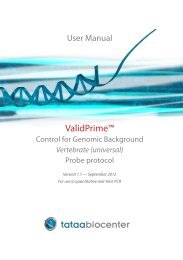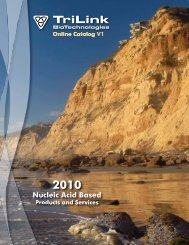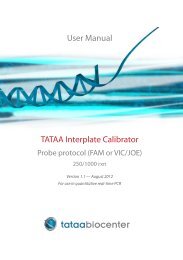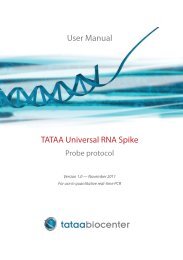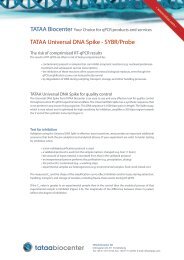Spectrophotometric and thermodynamic study on the dimerization ...
Spectrophotometric and thermodynamic study on the dimerization ...
Spectrophotometric and thermodynamic study on the dimerization ...
Create successful ePaper yourself
Turn your PDF publications into a flip-book with our unique Google optimized e-Paper software.
Spectrochimica Acta Part A 65 (2006) 73–78<br />
<str<strong>on</strong>g>Spectrophotometric</str<strong>on</strong>g> <str<strong>on</strong>g>and</str<strong>on</strong>g> <str<strong>on</strong>g><strong>the</strong>rmodynamic</str<strong>on</strong>g> <str<strong>on</strong>g>study</str<strong>on</strong>g> <strong>on</strong> <strong>the</strong> dimerizati<strong>on</strong><br />
equilibrium of i<strong>on</strong>ic dyes in water by chemometrics method<br />
Ali Niazi a,∗ , Ateesa Yazdanipour a , Jahanbakhsh Ghasemi b , Mikael Kubista c<br />
a Department of Chemistry, Faculty of Sciences, Azad University of Arak, Arak, Iran<br />
b Department of Chemistry, Faculty of Sciences, Razi University, Kermanshah, Iran<br />
c Department of Chemistry <str<strong>on</strong>g>and</str<strong>on</strong>g> Biosciences, Chalmers University of Technology, Go<strong>the</strong>nburg, Sweden<br />
Received 15 June 2005; accepted 22 September 2005<br />
Abstract<br />
The m<strong>on</strong>omer–dimer equilibrium <str<strong>on</strong>g>and</str<strong>on</strong>g> <str<strong>on</strong>g><strong>the</strong>rmodynamic</str<strong>on</strong>g> of several i<strong>on</strong>ic dyes (Neutral Red, Nile Blue A, Safranine T <str<strong>on</strong>g>and</str<strong>on</strong>g> Thi<strong>on</strong>ine) has been<br />
investigated by means of spectrophotometric <str<strong>on</strong>g>and</str<strong>on</strong>g> chemometrics methods. The dimerizati<strong>on</strong> c<strong>on</strong>stants of <strong>the</strong>se i<strong>on</strong>ic dyes have been determined by<br />
<str<strong>on</strong>g>study</str<strong>on</strong>g>ing <strong>the</strong> dependence of <strong>the</strong>ir absorpti<strong>on</strong> spectra <strong>on</strong> <strong>the</strong> temperature in <strong>the</strong> range 20–75 ◦ C at c<strong>on</strong>centrati<strong>on</strong>s of Neutral Red (1.73 × 10 −5 M),<br />
Nile Blue A (3.94 × 10 −5 M), Safranine (6.59 × 10 −5 M) <str<strong>on</strong>g>and</str<strong>on</strong>g> Thi<strong>on</strong>ine (6.60 × 10 −5 M). The m<strong>on</strong>omer–dimer equilibrium of <strong>the</strong>se dyes has been<br />
determined by chemometrics refinement of <strong>the</strong> absorpti<strong>on</strong> spectra obtained by <strong>the</strong>rmometric titrati<strong>on</strong>s performed. The processing of <strong>the</strong> data carried<br />
out for quantitative analysis of undefined mixtures, based <strong>on</strong> simultaneous resoluti<strong>on</strong> of <strong>the</strong> overlapping b<str<strong>on</strong>g>and</str<strong>on</strong>g>s in <strong>the</strong> whole set of absorpti<strong>on</strong> spectra.<br />
The enthalpy <str<strong>on</strong>g>and</str<strong>on</strong>g> entropy of <strong>the</strong> dimerizati<strong>on</strong> reacti<strong>on</strong>s were determined from <strong>the</strong> dependence of <strong>the</strong> equilibrium c<strong>on</strong>stants to <strong>the</strong> temperature (van’t<br />
Hoff equati<strong>on</strong>).<br />
© 2005 Elsevier B.V. All rights reserved.<br />
Keywords: Dimerizati<strong>on</strong>; Chemometrics; <str<strong>on</strong>g>Spectrophotometric</str<strong>on</strong>g>; Neutral Red; Nile Blue A; Safranine T; Thi<strong>on</strong>ine; I<strong>on</strong>ic dyes<br />
1. Introducti<strong>on</strong><br />
Many dyes dem<strong>on</strong>strate ability for self-associati<strong>on</strong> which has<br />
applicati<strong>on</strong>s in <strong>the</strong> photographic <str<strong>on</strong>g>and</str<strong>on</strong>g> dye industry [1]. The selfassociati<strong>on</strong><br />
phenomen<strong>on</strong> plays an important role in biological<br />
processes. The photoprocesses of aggregated molecules play an<br />
important role for <strong>the</strong> photosyn<strong>the</strong>sis in green plants <str<strong>on</strong>g>and</str<strong>on</strong>g> photosyn<strong>the</strong>tic<br />
bacteria [2]. Dimers as <strong>the</strong> simplest aggregates are <strong>the</strong><br />
subject of many studies c<strong>on</strong>cerned with <strong>the</strong> <str<strong>on</strong>g><strong>the</strong>rmodynamic</str<strong>on</strong>g>s of<br />
m<strong>on</strong>omer–dimer equilibrium <str<strong>on</strong>g>and</str<strong>on</strong>g> photo-physical properties, <str<strong>on</strong>g>and</str<strong>on</strong>g><br />
<strong>the</strong>refore being of special interest [3–10]. It is well known that<br />
<strong>the</strong> i<strong>on</strong>ic dyes tend to aggregate in diluted soluti<strong>on</strong>s, leading to<br />
dimer formati<strong>on</strong>, <str<strong>on</strong>g>and</str<strong>on</strong>g> sometimes even higher order aggregates.<br />
In such a case <strong>the</strong> molecular nature of dye is str<strong>on</strong>gly affected<br />
by, <str<strong>on</strong>g>and</str<strong>on</strong>g> <strong>the</strong>refore related to such parameters as dye c<strong>on</strong>centrati<strong>on</strong>,<br />
structure, i<strong>on</strong>ic strengths, temperature <str<strong>on</strong>g>and</str<strong>on</strong>g> presence of<br />
organic solvents [6–12]. Although dyes are very individualistic<br />
as structure <str<strong>on</strong>g>and</str<strong>on</strong>g>, of course behavior, certain broad rules are well<br />
∗ Corresp<strong>on</strong>ding author. Tel.: +98 8613663041x370; fax: +98 8613670017.<br />
E-mail address: ali.niazi@gmail.com (A. Niazi).<br />
established regarding <strong>the</strong> aggregati<strong>on</strong> in general. It may increase<br />
with an increase of dye c<strong>on</strong>centrati<strong>on</strong> or i<strong>on</strong>ic strengths; it will<br />
decrease with temperature rising or organic solvents adding;<br />
additi<strong>on</strong> to <strong>the</strong> dye structure of i<strong>on</strong>ic solubilizing groups will<br />
decrease aggregati<strong>on</strong>, whereas <strong>the</strong> inclusi<strong>on</strong> of l<strong>on</strong>g alkyl chains<br />
increase aggregati<strong>on</strong> because of higher hydrophobic interacti<strong>on</strong><br />
in soluti<strong>on</strong>.<br />
Spectroscopic methods are in general highly sensitive <str<strong>on</strong>g>and</str<strong>on</strong>g> as<br />
such suitable for <str<strong>on</strong>g>study</str<strong>on</strong>g>ing chemical equilibria in soluti<strong>on</strong>. When<br />
<strong>the</strong> comp<strong>on</strong>ents involved in <strong>the</strong> chemical equilibrium have distinct<br />
spectral resp<strong>on</strong>ses, <strong>the</strong>ir c<strong>on</strong>centrati<strong>on</strong>s can be measured<br />
directly, <str<strong>on</strong>g>and</str<strong>on</strong>g> <strong>the</strong> determinati<strong>on</strong> of <strong>the</strong> equilibrium c<strong>on</strong>stants is<br />
trivial. The absorpti<strong>on</strong> UV–vis spectroscopy is <strong>on</strong>e of <strong>the</strong> most<br />
suitable methods for quantitative <str<strong>on</strong>g>study</str<strong>on</strong>g>ing <strong>the</strong> aggregati<strong>on</strong> phenomena<br />
of dyes as functi<strong>on</strong> of c<strong>on</strong>centrati<strong>on</strong> [13–17]. In<strong>the</strong><br />
comm<strong>on</strong>ly used c<strong>on</strong>centrati<strong>on</strong> range (10 −3 to 10 −6 M) <strong>the</strong> main<br />
equilibrium is m<strong>on</strong>omer–dimer reacti<strong>on</strong>. In this work, we used<br />
physical c<strong>on</strong>straints to determine <strong>the</strong> dimeric c<strong>on</strong>stants of i<strong>on</strong>ic<br />
dyes (Scheme 1) in pure water.<br />
Data analysis was carried out by DATAN package that developed<br />
by Kubista et al. [18–23]. The <strong>the</strong>ory <str<strong>on</strong>g>and</str<strong>on</strong>g> applicati<strong>on</strong> of<br />
physical c<strong>on</strong>straints method was discussed by Kubista et al. in<br />
1386-1425/$ – see fr<strong>on</strong>t matter © 2005 Elsevier B.V. All rights reserved.<br />
doi:10.1016/j.saa.2005.09.030
74 A. Niazi et al. / Spectrochimica Acta Part A 65 (2006) 73–78<br />
Scheme 1.<br />
several papers [18–26]. However, <strong>the</strong> general principal will be<br />
outlined briefly.<br />
The absorpti<strong>on</strong> spectra are digitized <str<strong>on</strong>g>and</str<strong>on</strong>g> arranged as rows in a<br />
matrix A. Matrix A is <strong>the</strong>n decomposed into an orthog<strong>on</strong>al basis<br />
set using, for example, <strong>the</strong> NIPALS routine [18]:<br />
A = TP + E ≈ TP =<br />
r∑<br />
t i p ′ i (1)<br />
i=1<br />
where t i are orthog<strong>on</strong>al target vectors <str<strong>on</strong>g>and</str<strong>on</strong>g> p ′ i are orthog<strong>on</strong>al<br />
projecti<strong>on</strong> vectors, E is <strong>the</strong> error matrix, <str<strong>on</strong>g>and</str<strong>on</strong>g> r <strong>the</strong> number of<br />
spectroscopically distinguishable comp<strong>on</strong>ents, which is two in<br />
this case. Assuming linear resp<strong>on</strong>se <strong>the</strong> recorded spectra are<br />
also linear combinati<strong>on</strong>s of <strong>the</strong> spectral resp<strong>on</strong>ses, v i ,of<strong>the</strong><br />
comp<strong>on</strong>ents:<br />
A = CV + E ≈ CV =<br />
r∑<br />
c i v i (2)<br />
i=1<br />
where c i are vectors c<strong>on</strong>taining <strong>the</strong> comp<strong>on</strong>ent c<strong>on</strong>centrati<strong>on</strong>s<br />
at <strong>the</strong> different temperatures. Eqs. (3) <str<strong>on</strong>g>and</str<strong>on</strong>g> (4) are related by a<br />
rotati<strong>on</strong>:<br />
C = T R −1 (3)<br />
V = RP (4)<br />
where R is an r × r rotati<strong>on</strong> matrix, for which a two-comp<strong>on</strong>ent<br />
system has <strong>the</strong> element:<br />
[ ]<br />
r11 r 12<br />
R =<br />
(5)<br />
r 21 r 22<br />
Two c<strong>on</strong>straints are used to determine three of <strong>the</strong> element in<br />
R. The first is <strong>the</strong> spectrum of m<strong>on</strong>omer, which is measured<br />
separately, <str<strong>on</strong>g>and</str<strong>on</strong>g> <strong>the</strong> sec<strong>on</strong>d is <strong>the</strong> c<strong>on</strong>stant total c<strong>on</strong>centrati<strong>on</strong> of<br />
<strong>the</strong> dye:<br />
c x (T ) + 2c x2 (T ) = c tot (6)<br />
Matrix R can now be described by a single scalar r 21 , <str<strong>on</strong>g>and</str<strong>on</strong>g> o<strong>the</strong>r<br />
factors that are determined by <strong>the</strong> c<strong>on</strong>straints. The value of r 21<br />
determines <strong>the</strong> dimer spectrum <str<strong>on</strong>g>and</str<strong>on</strong>g> <strong>the</strong> m<strong>on</strong>omer c<strong>on</strong>centrati<strong>on</strong><br />
profiles. Although many values of r 21 produces a ma<strong>the</strong>matically<br />
acceptable soluti<strong>on</strong>, reas<strong>on</strong>able results in terms of spectral intensities<br />
<str<strong>on</strong>g>and</str<strong>on</strong>g> n<strong>on</strong>-negative c<strong>on</strong>centrati<strong>on</strong>s, <str<strong>on</strong>g>and</str<strong>on</strong>g> spectral resp<strong>on</strong>ses<br />
are obtained in a relatively narrow range of r 21 values. Still,<br />
<strong>the</strong> range is, in general, too large for a quantitative analysis.<br />
The final c<strong>on</strong>straint, which produces a unique soluti<strong>on</strong>, is <strong>the</strong><br />
<str<strong>on</strong>g><strong>the</strong>rmodynamic</str<strong>on</strong>g> relati<strong>on</strong> between temperature <str<strong>on</strong>g>and</str<strong>on</strong>g> <strong>the</strong> equilibrium<br />
c<strong>on</strong>stant. The comp<strong>on</strong>ents’ c<strong>on</strong>centrati<strong>on</strong>s are related by<br />
<strong>the</strong> law of mass acti<strong>on</strong> [31]:<br />
K D (T ) =<br />
c x 2<br />
(T )/c ◦<br />
(c x (T )/c ◦ ) 2 (7)<br />
where c ◦ = 1 mol/dm 3 . Assuming that <strong>the</strong> dimerizati<strong>on</strong> c<strong>on</strong>stant<br />
K D (T) depends <strong>on</strong> temperature according to <strong>the</strong> van’t Hoff equati<strong>on</strong><br />
[31],<br />
dlnK D (T )<br />
d(1/T)<br />
= −H ◦<br />
R<br />
where H ◦ is <strong>the</strong> molar enthalpy change, R = 8.31 J mol −1 K −1<br />
<strong>the</strong> universal gas c<strong>on</strong>stant, <str<strong>on</strong>g>and</str<strong>on</strong>g> T <strong>the</strong> Kelvin temperature. A linear<br />
regressi<strong>on</strong> of equilibrium c<strong>on</strong>stants with respect to 1/T is <strong>the</strong>n<br />
performed, which determines a trial enthalpy change of <strong>the</strong> reacti<strong>on</strong>.<br />
Several studies based <strong>on</strong> <strong>the</strong> applicati<strong>on</strong> of this method to<br />
spectrophotometric data have been reported [11,12,27–29]. The<br />
analysis is readily performed with <strong>the</strong> DATAN program [30].<br />
2. Experimental<br />
2.1. Material<br />
All <strong>the</strong> chemicals used were of analytical reagent grade. Subboiling<br />
distilled water was used throughout. Neutral Red, Nile<br />
Blue A, Safranine T <str<strong>on</strong>g>and</str<strong>on</strong>g> Thi<strong>on</strong>ine (for microscopy grade) were<br />
purchased from Fluka <str<strong>on</strong>g>and</str<strong>on</strong>g> were used without additi<strong>on</strong>al purificati<strong>on</strong>.<br />
A stock soluti<strong>on</strong> (5 × 10 −4 M) was prepared by dissolving<br />
<strong>the</strong>se solid i<strong>on</strong>ic dyes in water. The pH of <strong>the</strong> all soluti<strong>on</strong>s was<br />
kept c<strong>on</strong>stant at 7.00 using Tris buffer.<br />
(8)
A. Niazi et al. / Spectrochimica Acta Part A 65 (2006) 73–78 75<br />
2.2. Apparatus<br />
Absorpti<strong>on</strong> spectra were measured <strong>on</strong> CARY 100 UV–vis<br />
spectrophotometer (Varian) equipped by 6 × 6 multi-cell <str<strong>on</strong>g>and</str<strong>on</strong>g><br />
temperature c<strong>on</strong>troller <str<strong>on</strong>g>and</str<strong>on</strong>g> were digitized with five data<br />
points/nm. C<strong>on</strong>venti<strong>on</strong>al quartz cells (10 mm × 10 mm) <str<strong>on</strong>g>and</str<strong>on</strong>g><br />
(10 mm × 1 mm) were used throughout. The cuvettes were<br />
treated with repel-silane prior to measurements to avoid dye<br />
adsorpti<strong>on</strong>. The pH values were measured by a Metrohm 692<br />
furnished with combined calomel Ag/AgCl electrode.<br />
2.3. Computer hardware <str<strong>on</strong>g>and</str<strong>on</strong>g> software<br />
All absorpti<strong>on</strong> spectra where digitized at five data points/nm<br />
in <strong>the</strong> wavelengths 400–650 nm, 500–720 nm, 400–650 nm <str<strong>on</strong>g>and</str<strong>on</strong>g><br />
450–650 nm for Neutral Red, Nile Blue A, Safranine T <str<strong>on</strong>g>and</str<strong>on</strong>g><br />
Thi<strong>on</strong>ine, respectively, <str<strong>on</strong>g>and</str<strong>on</strong>g> transferred (in ASCII format) to an<br />
Athl<strong>on</strong> 2000 XP computer for analysis by MATLAB (Mathworks,<br />
Versi<strong>on</strong> 6.5) or for processing by using DATAN package<br />
[30].<br />
3. Results <str<strong>on</strong>g>and</str<strong>on</strong>g> discussi<strong>on</strong><br />
The absorpti<strong>on</strong> spectra of Neutral Red, Nile Blue A, Safranine<br />
T <str<strong>on</strong>g>and</str<strong>on</strong>g> Thi<strong>on</strong>ine, were recorded between 400 <str<strong>on</strong>g>and</str<strong>on</strong>g> 650 nm,<br />
500 <str<strong>on</strong>g>and</str<strong>on</strong>g> 720 nm, 400 <str<strong>on</strong>g>and</str<strong>on</strong>g> 650 nm, <str<strong>on</strong>g>and</str<strong>on</strong>g> 450 <str<strong>on</strong>g>and</str<strong>on</strong>g> 650 nm, respectively,<br />
in <strong>the</strong> temperature range 20–75 ◦ Cat5 ◦ C intervals <str<strong>on</strong>g>and</str<strong>on</strong>g><br />
pH 7.00; absorpti<strong>on</strong> spectra are shown in Fig. 1. As it is<br />
expected, by increasing <strong>the</strong> temperature, <strong>the</strong> m<strong>on</strong>omer form<br />
would be predominant over <strong>the</strong> dimer form. So it is wise<br />
to choose <strong>the</strong> spectrum of <strong>the</strong> dye at <strong>the</strong> highest temperature<br />
as an initial estimate for <strong>the</strong> m<strong>on</strong>omer in <strong>the</strong> subsequent<br />
calculati<strong>on</strong>.<br />
According to Eqs. (1)–(8) <strong>the</strong> DATAN program start with a<br />
trial value of r 21 , at predefined interval, <str<strong>on</strong>g>and</str<strong>on</strong>g> iterate all <strong>the</strong> calculati<strong>on</strong><br />
steps. The iterati<strong>on</strong> stops when all r 21 values in <strong>the</strong> preset<br />
interval are tested. The K D , dimer spectrum <str<strong>on</strong>g>and</str<strong>on</strong>g> H, corresp<strong>on</strong>d<br />
to minimum value of <strong>the</strong> χ 2 statistics, are selected as <strong>the</strong> final<br />
results. The χ 2 is <strong>the</strong> sum of squared residuals [19] <str<strong>on</strong>g>and</str<strong>on</strong>g> generally<br />
used as a goodness of fit criteri<strong>on</strong>, <str<strong>on</strong>g>and</str<strong>on</strong>g> its value indicate <strong>the</strong><br />
predictability of <strong>the</strong> model, i.e. how well <strong>the</strong> m<strong>on</strong>omer spectrum<br />
<str<strong>on</strong>g>and</str<strong>on</strong>g> r 21 are determined. The general formula of <strong>the</strong> χ 2 is:<br />
n∑<br />
χ 2 (A exp − A calc ) 2<br />
=<br />
(9)<br />
A exp<br />
i=1<br />
where A exp is <strong>the</strong> expected value <str<strong>on</strong>g>and</str<strong>on</strong>g> A calc is calculated form<br />
experimental data over n data point.<br />
With increasing temperature <strong>the</strong> absorpti<strong>on</strong> peak for Neutral<br />
Red, Nile Blue A, Safranine T <str<strong>on</strong>g>and</str<strong>on</strong>g> Thi<strong>on</strong>ine, around 535, 635,<br />
520 <str<strong>on</strong>g>and</str<strong>on</strong>g> 595 nm grows, <str<strong>on</strong>g>and</str<strong>on</strong>g> <strong>the</strong> absorpti<strong>on</strong> around 500, 590, 495<br />
<str<strong>on</strong>g>and</str<strong>on</strong>g> 560 nm decrease (Fig. 1). We analyzed <strong>the</strong> temperature titrati<strong>on</strong>s<br />
assuming m<strong>on</strong>omer–dimer, m<strong>on</strong>omer–dimmer–trimer <str<strong>on</strong>g>and</str<strong>on</strong>g><br />
even some tested models including higher order aggregates, <str<strong>on</strong>g>and</str<strong>on</strong>g><br />
found that <strong>the</strong> m<strong>on</strong>omer–dimer model most adequately describes<br />
<strong>the</strong> data in <strong>the</strong>se range of used c<strong>on</strong>centrati<strong>on</strong>s. The presence<br />
of exactly two species is also evidenced by appearing of <strong>the</strong><br />
isobestic points at 515, 605, 508 <str<strong>on</strong>g>and</str<strong>on</strong>g> 570 nm for Neutral Red,<br />
Nile Blue A, Safranine T <str<strong>on</strong>g>and</str<strong>on</strong>g> Thi<strong>on</strong>ine, respectively.<br />
The dimerizati<strong>on</strong> c<strong>on</strong>stants (K D ) were calculated at different<br />
temperatures. As expected K D decreased with increasing<br />
temperature, while it is virtually independent of total dye c<strong>on</strong>centrati<strong>on</strong>.<br />
From <strong>the</strong> dependence of log K D <strong>on</strong> 1/T (Fig. 2) H ◦<br />
Fig. 1. Absorpti<strong>on</strong> spectra of: (a) Neutral Red (1.73 × 10 −5 M), (b) Nile Blue A (3.94 × 10 −5 M), (c) Safranine (6.59 × 10 −5 M) <str<strong>on</strong>g>and</str<strong>on</strong>g> (d) Thi<strong>on</strong>ine (6.60 × 10 −5 M)<br />
in 5 ◦ C intervals between 20 <str<strong>on</strong>g>and</str<strong>on</strong>g> 75 ◦ C at pH 7.00 in water.
76 A. Niazi et al. / Spectrochimica Acta Part A 65 (2006) 73–78<br />
Fig. 2. The van’t Hoff equati<strong>on</strong> plot of: (a) Neutral Red, (b) Nile Blue A, (c) Safranine T <str<strong>on</strong>g>and</str<strong>on</strong>g> (d) Thi<strong>on</strong>ine dyes.<br />
<str<strong>on</strong>g>and</str<strong>on</strong>g> S ◦ values were determined. The dimerizati<strong>on</strong> c<strong>on</strong>stants at<br />
25 ◦ C <str<strong>on</strong>g>and</str<strong>on</strong>g> <str<strong>on</strong>g><strong>the</strong>rmodynamic</str<strong>on</strong>g> parameters of <strong>the</strong> dimerizati<strong>on</strong> reacti<strong>on</strong>s<br />
of <strong>the</strong> Neutral Red, Nile Blue A, Safranine T <str<strong>on</strong>g>and</str<strong>on</strong>g> Thi<strong>on</strong>ine<br />
dyes are listed in Table 1. As described above dimerizati<strong>on</strong> is<br />
presumed to be <strong>the</strong> dominant form of aggregati<strong>on</strong> in applied c<strong>on</strong>centrati<strong>on</strong><br />
in aqueous Neutral Red, Nile Blue A, Safranine T <str<strong>on</strong>g>and</str<strong>on</strong>g><br />
Thi<strong>on</strong>ine. This is corroborated by <strong>the</strong> c<strong>on</strong>stancy of <strong>the</strong> apparent<br />
enthalpy of associati<strong>on</strong>. In general, <strong>the</strong> extent of aggregati<strong>on</strong><br />
depends reciprocally <strong>on</strong> <strong>the</strong> temperature of <strong>the</strong> soluti<strong>on</strong> <str<strong>on</strong>g>and</str<strong>on</strong>g> is<br />
fully reversible. The observed relati<strong>on</strong>ship between entropy <str<strong>on</strong>g>and</str<strong>on</strong>g><br />
enthalpy reflects an electrostatic nature of <strong>the</strong> dimerizati<strong>on</strong> phenomen<strong>on</strong><br />
of <strong>the</strong>se i<strong>on</strong>ic dyes. The relative dependence of <strong>the</strong><br />
c<strong>on</strong>centrati<strong>on</strong>s of <strong>the</strong> m<strong>on</strong>omer <str<strong>on</strong>g>and</str<strong>on</strong>g> dimer of Neutral Red, Nile<br />
Blue A, Safranine T <str<strong>on</strong>g>and</str<strong>on</strong>g> Thi<strong>on</strong>ine dyes <strong>on</strong> <strong>the</strong> temperature in<br />
Fig. 3. Molar ratio of: (a) Neutral Red, (b) Nile Blue A, (c) Safranine T <str<strong>on</strong>g>and</str<strong>on</strong>g> (d) Thi<strong>on</strong>ine dyes m<strong>on</strong>omer (△) <str<strong>on</strong>g>and</str<strong>on</strong>g> dimer (□), compared to molar ratios predicted by<br />
<strong>the</strong> temperature dependence of <strong>the</strong> equilibrium c<strong>on</strong>stant (shown as line) in water (temperature unit is ◦ K scale).
A. Niazi et al. / Spectrochimica Acta Part A 65 (2006) 73–78 77<br />
Fig. 4. Calculated absorpti<strong>on</strong> spectra of: (a) Neutral Red, (b) Nile Blue A, (c) Safranine T <str<strong>on</strong>g>and</str<strong>on</strong>g> (d) Thi<strong>on</strong>ine dyes.<br />
Table 1<br />
Dimeric c<strong>on</strong>stant <str<strong>on</strong>g>and</str<strong>on</strong>g> <str<strong>on</strong>g><strong>the</strong>rmodynamic</str<strong>on</strong>g> parameters values of Neutral Red<br />
(1.73 × 10 −5 M), Nile Blue A (3.94 × 10 −5 M), Safranine (6.59 × 10 −5 M) <str<strong>on</strong>g>and</str<strong>on</strong>g><br />
Thi<strong>on</strong>ine (6.60 × 10 −5 M) dyes in water<br />
Dye Neutral Red Nile Blue A Safranine T Thi<strong>on</strong>ine<br />
log K D (25 ◦ C) 6.21 5.31 4.73 4.64<br />
H ◦ (kJ mol −1 ) −108.5 −109.1 −106.7 −90.8<br />
S ◦ (J mol −1 K −1 ) −244.5 −265.4 −267.9 −216.4<br />
different c<strong>on</strong>centrati<strong>on</strong> are shown diagrammatically in Fig. 3.<br />
The calculated absorpti<strong>on</strong> spectra of Neutral Red, Nile Blue A,<br />
Safranine T <str<strong>on</strong>g>and</str<strong>on</strong>g> Thi<strong>on</strong>ine dyes in m<strong>on</strong>omer <str<strong>on</strong>g>and</str<strong>on</strong>g> dimer forms are<br />
shown in Fig. 4.<br />
4. C<strong>on</strong>clusi<strong>on</strong><br />
In this <str<strong>on</strong>g>study</str<strong>on</strong>g> we report for <strong>the</strong> first time to our knowledge<br />
a <str<strong>on</strong>g><strong>the</strong>rmodynamic</str<strong>on</strong>g>s <str<strong>on</strong>g>study</str<strong>on</strong>g> of <strong>the</strong> dimerizati<strong>on</strong> equilibrium of <strong>the</strong><br />
Neutral Red, Nile Blue A, Safranine T <str<strong>on</strong>g>and</str<strong>on</strong>g> Thi<strong>on</strong>ine dyes in<br />
aqueous soluti<strong>on</strong>. Dimerizati<strong>on</strong> c<strong>on</strong>stants, c<strong>on</strong>centrati<strong>on</strong> profiles<br />
for <strong>the</strong> m<strong>on</strong>omer <str<strong>on</strong>g>and</str<strong>on</strong>g> dimer, <str<strong>on</strong>g>and</str<strong>on</strong>g> spectral resp<strong>on</strong>ses of m<strong>on</strong>omer<br />
<str<strong>on</strong>g>and</str<strong>on</strong>g> dimer obtained by computer refinement of temperature photometric<br />
titrati<strong>on</strong>s. The <str<strong>on</strong>g><strong>the</strong>rmodynamic</str<strong>on</strong>g> parameters, enthalpy<br />
<str<strong>on</strong>g>and</str<strong>on</strong>g> entropy of dimerizati<strong>on</strong> reacti<strong>on</strong> were calculated from <strong>the</strong><br />
dependence of dimeric c<strong>on</strong>stant <strong>on</strong> <strong>the</strong> temperature (van’t Hoff<br />
equati<strong>on</strong>).<br />
References<br />
[1] A.K. Chibisov, T.D. Slavnova, H. Gorner, Chem. Phys. Lett. 386 (2004)<br />
301.<br />
[2] T. Miyatake, H. Tamiaki, A.R. Holzwarth, K. Schaffner, Helv. Chim.<br />
Acta 82 (1999) 797.<br />
[3] B.C. Burdett, Aggregati<strong>on</strong> of Dyes, in Studies in Physical <str<strong>on</strong>g>and</str<strong>on</strong>g> Theoretical<br />
Chemistry, vol. 2, Elsevier, 1983.<br />
[4] R. Pepperkok, R. Saffrich, Microinjecti<strong>on</strong> <str<strong>on</strong>g>and</str<strong>on</strong>g> Detecti<strong>on</strong> of Probes in<br />
Cells, EMBL, Heidelberg, 1999.<br />
[5] S. Miljanic, Z. Cimerman, L. Frkanec, M. Zinic, Anal. Chim. Acta 468<br />
(2002) 13.<br />
[6] N.O. Mchedlov-Petrossyan, Y.V. Kholin, Russ. J. Appl. Chem. 77 (2004)<br />
414.<br />
[7] J.C. Micheau, G.V. Zakharova, A.K. Chibisov, Phys. Chem. Chem. Phys.<br />
6 (2004) 2420.<br />
[8] L. Ant<strong>on</strong>ov, G. Gergov, V. Petrov, M. Kubista, J. Nygren, Talanta 49<br />
(1999) 99.<br />
[9] L. Evans III, G. Pat<strong>on</strong>ay, Talanta 48 (1999) 933.<br />
[10] G.J. Su, S.X. Yin, L.J. Wan, J.C. Zhao, C.L. Bai, Surf. Sci. 551 (2004)<br />
204.<br />
[11] J. Ghasemi, A. Niazi, G. Westman, M. Kubista, Talanta 62 (2004)<br />
835.<br />
[12] J. Ghasemi, A. Niazi, M. Kubista, Spectrochim. Acta Part A, in press.<br />
[13] I. Baraldi, M. Caselli, F. Momicchioli, G. P<strong>on</strong>tereini, D. Vanossi, Chem.<br />
Phys. 275 (2002) 149.<br />
[14] A.G. Gilani, R. Sariri, K. Bahrpaima, Spectrochim. Acta Part A 57<br />
(2001) 155.<br />
[15] M.T.M. Choi, P.P.S. Li, D.K.P. Ng, Tetrahedr<strong>on</strong> 56 (2000) 3881.<br />
[16] A.K. Chibisov, V.I. Prokhorenko, H. Gorner, Chem. Phys. 250 (1999)<br />
47.<br />
[17] K. Patil, R. Pawar, P. Talap, Phys. Chem. Chem. Phys. 2 (2000)<br />
4313.<br />
[18] M. Kubista, R. Sjoback, J. Nygren, Anal. Chim. Acta 302 (1995) 121.<br />
[19] M. Kubista, J. Nygren, A. Elbergali, R. Sjoback, Crit. Rev. Anal. Chem.<br />
29 (1999) 1.<br />
[20] M. Kubista, R. Sjoback, B. Albinss<strong>on</strong>, Anal. Chem. 65 (1993)<br />
994.<br />
[21] I. Scarminio, M. Kubista, Anal. Chem. 65 (1993) 409.<br />
[22] A. Elbergali, J. Nygren, M. Kubista, Anal. Chim. Acta 379 (1999) 143.<br />
[23] J. Nygren, J.M. Andrade, M. Kubista, Anal. Chem. 68 (1996) 1706.
78 A. Niazi et al. / Spectrochimica Acta Part A 65 (2006) 73–78<br />
[24] N. Svanvik, J. Nygren, G. Westman, M. Kubista, J. Am. Chem. Soc.<br />
123 (2001) 803.<br />
[25] J. Nygren, N. Svanvik, M. Kubista, Biopolymers 46 (1998) 39.<br />
[26] J. Nygren, A. Elbergali, M. Kubista, Anal. Chem. 70 (1998) 4841.<br />
[27] J. Ghasemi, A. Niazi, M. Kubista, A. Elbergali, Anal. Chim. Acta 455<br />
(2002) 335.<br />
[28] J. Ghasemi, Sh. Ahmadi, M. Kubista, A. Forootan, J. Chem. Eng. Data<br />
48 (2003) 1178.<br />
[29] A. Rouhollahi, F.M. Kiaie, J. Ghasemi, Talanta 66 (2005) 653.<br />
[30] http://www.multid.se.<br />
[31] L.V. Levine, Physical Chemistry, McGraw-Hill, New York, 1988.



